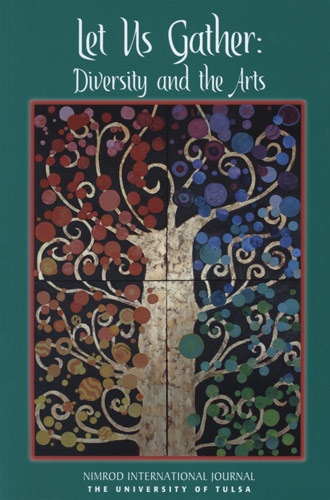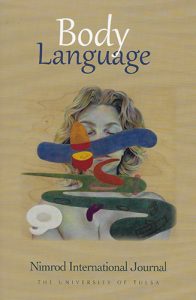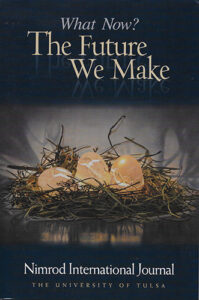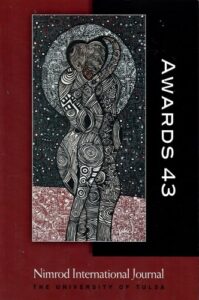Nimrod International Journal – Spring/Summer 2018
While it’s not new to group “the arts” under a single umbrella of creativity, Nimrod expands this umbrella even further to consider the arts merged with diversity. Editor Eilis O’Neal breaks the poetry and fiction down into two categories: work about the arts (broadly speaking), and work by diverse artists (broadly speaking). There’s no division between these two categories within the table of contents or anywhere in the magazine, creating a seamless flow from piece to piece. Nimrod is expansively inclusive in what defines art and what defines diversity. This inclusivity aids in how welcoming the magazine is. Nimrod creates a place to gather and share stories.
While it’s not new to group “the arts” under a single umbrella of creativity, Nimrod expands this umbrella even further to consider the arts merged with diversity. Editor Eilis O’Neal breaks the poetry and fiction down into two categories: work about the arts (broadly speaking), and work by diverse artists (broadly speaking). There’s no division between these two categories within the table of contents or anywhere in the magazine, creating a seamless flow from piece to piece. Nimrod is expansively inclusive in what defines art and what defines diversity. This inclusivity aids in how welcoming the magazine is. Nimrod creates a place to gather and share stories.
Sophia Stid is the poetry winner of the first Francine Ringold Award for New Writers. In her poem “Rust Wilderness,” the narrator reflects on her youth growing up on a dying farm, being surrounded by older family members, and the heaviness of death all around her. Stid parallels the dying farm to her family members dealing with their own illnesses and grief, such as her Great Aunt Eliza, whose amputated leg “ended in an open mouth. Her long rubbery breasts tigered / by silverfish stretch marks. // That body could only have come from that town.” The pervasiveness of death and decay follows through the three parts of the poem and is paired effectively with Christopher Woods’s black and white photograph “Barbed Wire, Brenham”: a bleak farm scene with barbed wire crossing in the foreground.
Sandra K. Barnidge is a fiction finalist for the Francine Ringold Award for her story “The Waubeen Annual Kanaranzi Kimball Day.” Set in the near future, Kanaranzi Kimball (nicknamed KayKay) is an international celebrity in a vicious extension of current reality TV: a camera ball watches KayKay every second. Barnidge’s most ambitious piece in this story is her narrator, a woman who had been KayKay’s best friend before KayKay was discovered. This narrator cannot see the destruction of KayKay’s life and still believes KayKay will come back for her and she’ll get whisked away into the fame and attention of celebrity life. Barnridge takes the concept of reality TV and adds a level of complexity: a complicit narrator bound up in the community that supports the violence committed against KayKay as a female public figure.
In “Natural History,” Erin Adair-Hodges probes at gender, specifically masculinity and the community of men. Adair-Hodges chooses violent language to describe a boy at a natural history museum as he rushes about the dinosaur displays: “he is a meteor”; he will “[enter] the world of men / like a fist”; he and the other boys in the class are “a school of disaster engines.” And as the narrator watches the young boy, she is worried about the people and communities he will hurt. She thinks of the damage his masculinity will do.
Julia Lisella directly addresses art in her poem “Mercy.” The poem centers on a schoolgirl who does not follow the rules of the classroom art project. She divides her paper into four sections to draw the seasons, but leaves the sections uneven. When the teacher collects each student’s drawing:
this girl will not say no
but will hand it over
as if she knows already that the slight shame she feels
should not be hidden
Lisella considers female creativity, the need to conform, and the desire to apologize when women don’t conform.
Another finalist for the Francine Ringold Award, “The Rickies” by Sarah Curry also focuses on women who seek to form their own community. The four Rickies are originally Lisa, Annabelle, Beth, and Claire. But as four survivors of sexual assault, they come together to form the group The Rickies, where each woman changes her name to Ricky to form a pseudo-girl gang. Curry lingers in what this gathering of Rickies cannot achieve: the Rickies are more concerned with being rebellious and mysterious than with healing. The Rickies graduate from college and begin adult lives, going their separate ways. But Belle is raped again and the narrator attempts to go back to the days of the Rickies, “I offered to sneak into [the rapist’s] condo and chop off his toe, because that’s what has to be said.” The narrator keeps the memories of the Rickies in a box under her bed, as a way to keep the group alive, and a way to remember all their community could still mean.
Nimrod’s Diversity and the Arts issue makes no attempt to put diversity into a box. What makes this issue such a welcoming place for readers is that what the authors bring to the diversity table is not always expressly clear in the content or the authors’ bio. To gather amongst difference without naming or sectioning off the differences creates a space of inquiry and discovery.
[nimrod.utulsa.edu]





